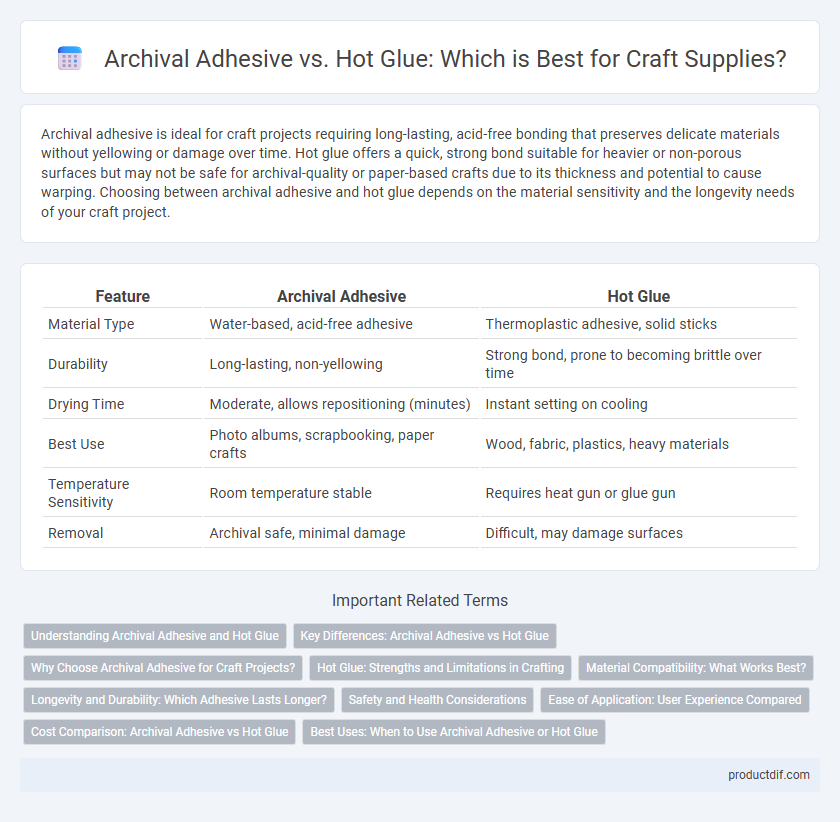Archival adhesive is ideal for craft projects requiring long-lasting, acid-free bonding that preserves delicate materials without yellowing or damage over time. Hot glue offers a quick, strong bond suitable for heavier or non-porous surfaces but may not be safe for archival-quality or paper-based crafts due to its thickness and potential to cause warping. Choosing between archival adhesive and hot glue depends on the material sensitivity and the longevity needs of your craft project.
Table of Comparison
| Feature | Archival Adhesive | Hot Glue |
|---|---|---|
| Material Type | Water-based, acid-free adhesive | Thermoplastic adhesive, solid sticks |
| Durability | Long-lasting, non-yellowing | Strong bond, prone to becoming brittle over time |
| Drying Time | Moderate, allows repositioning (minutes) | Instant setting on cooling |
| Best Use | Photo albums, scrapbooking, paper crafts | Wood, fabric, plastics, heavy materials |
| Temperature Sensitivity | Room temperature stable | Requires heat gun or glue gun |
| Removal | Archival safe, minimal damage | Difficult, may damage surfaces |
Understanding Archival Adhesive and Hot Glue
Archival adhesive is designed to provide a long-lasting, acid-free bond that preserves delicate materials such as paper, fabric, and photos without causing damage or discoloration over time. Hot glue offers a quick, strong bond ideal for a wide range of materials but may not be suitable for preserving valuable or fragile items due to its potential to yellow or degrade. Choosing between archival adhesive and hot glue depends on the project's need for durability, preservation, and material compatibility.
Key Differences: Archival Adhesive vs Hot Glue
Archival adhesive is designed for long-term preservation, offering acid-free, non-yellowing properties that prevent damage to delicate materials such as paper and photos, making it ideal for scrapbooking and paper crafts. Hot glue provides a fast, strong bond suitable for three-dimensional and heavier objects like fabric, wood, and plastics but may cause warping or staining and is not reversible. The key difference lies in archival adhesive's emphasis on longevity and material safety versus hot glue's strength and versatility for robust crafting projects.
Why Choose Archival Adhesive for Craft Projects?
Archival adhesive preserves the longevity and integrity of craft projects by offering acid-free, non-yellowing properties that prevent damage over time, unlike hot glue which can become brittle and discolored. Its superior bonding quality is ideal for delicate materials such as paper, fabric, and photographs, ensuring artwork and crafts maintain their appearance. Selecting archival adhesive ensures professional-grade results with durability essential for scrapbooking, card making, and other fine crafts.
Hot Glue: Strengths and Limitations in Crafting
Hot glue offers quick bonding and versatility on various materials such as fabric, wood, and plastics, making it a popular choice for craft projects requiring immediate adhesion. Its strength lies in forming a flexible, durable bond that withstands moderate stress and temperature changes, enhancing project longevity. However, hot glue can be bulky when applied, may not adhere well to porous surfaces like paper, and risks burns during use, limiting precision in delicate crafts.
Material Compatibility: What Works Best?
Archival adhesive offers superior material compatibility for delicate papers, photos, and fabrics due to its acid-free and non-yellowing properties, ensuring long-term preservation without damage. Hot glue, while providing strong bonds on porous and non-porous surfaces like wood, plastic, and metal, may cause damage to heat-sensitive materials and is less suitable for archival-quality projects. Selecting the right adhesive depends on the craft material's sensitivity and the need for durability versus preservation quality.
Longevity and Durability: Which Adhesive Lasts Longer?
Archival adhesive offers superior longevity and durability compared to hot glue, as it is specifically formulated to withstand aging without yellowing or becoming brittle, ensuring materials remain securely bonded over time. Hot glue, while providing a strong initial bond, tends to degrade faster due to its sensitivity to heat and environmental changes, leading to potential weakening and eventual failure. For projects requiring long-term preservation and reliability, archival adhesive is the preferred choice in craft supplies.
Safety and Health Considerations
Archival adhesives use acid-free, non-toxic formulas that ensure long-term preservation without releasing harmful fumes, making them safer for prolonged indoor use and sensitive craft projects. Hot glue emits heat and fumes that can cause skin burns and respiratory irritation, requiring careful handling and well-ventilated spaces to minimize health risks. Choosing archival adhesive benefits projects needing durability and non-reactive bonding with fewer health concerns compared to hot glue.
Ease of Application: User Experience Compared
Archival adhesive offers a controlled application with minimal mess, ideal for precise, long-lasting craft projects requiring acid-free bonding. Hot glue provides rapid adhesion and versatility on various materials but can be messy and requires caution with temperature sensitivity. Users seeking neatness and durability often prefer archival adhesive, while those valuing speed and flexibility lean towards hot glue.
Cost Comparison: Archival Adhesive vs Hot Glue
Archival adhesive typically costs more upfront than hot glue due to its specialized formulation designed for long-term preservation and acid-free bonding. Hot glue, being widely available and produced in bulk, offers a lower initial price but may require more frequent repairs or replacements in delicate or archival projects. When considering cost-effectiveness, archival adhesive's durability and non-damaging properties often justify its higher price for valuable or sentimental crafts.
Best Uses: When to Use Archival Adhesive or Hot Glue
Archival adhesive is best used for preserving delicate materials in scrapbooking, photo albums, and paper crafts where longevity and acid-free properties are crucial. Hot glue is ideal for quick, strong bonds on non-porous materials like fabric, wood, and plastic, making it perfect for larger craft projects or decorations. Choosing between archival adhesive and hot glue depends on the need for durability, speed, and material compatibility in your craft project.
Archival adhesive vs Hot glue Infographic

 productdif.com
productdif.com